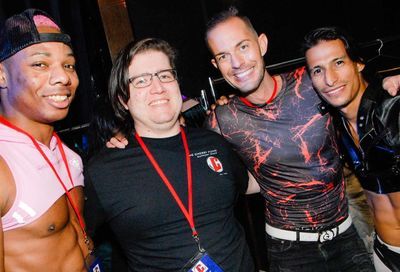Bite Night
In '30 Days of Night' gore serves as a replacement for genuine terror and dread. It's hardly horrific.
”I don’t care what they are,” barks an anxious Sheriff Eben Oleson (Josh Hartnett). ”I just care what they do about them!”
And well he should care. They’re vampires. And they’ve come to feed on his remote Alaskan town, plunged into month-long darkness in 30 Days of Night.
The movie, directed by David Slade (Hard Candy), and based on a graphic novel, is an attempt to revitalize the undead bloodsucker genre. Stripped of any romanticism (there’s no erotic charge to these beasts; they’re simply feral eating machines with dirty fingernails and long, pointy teeth) and pumped up with a considerable amount of gore and faux atmospherics, 30 Days of Night could have been the next evolution in the vampire oeuvre. It could have been the new Near Dark.
 George and Harnett |
Except that it’s not.
Slade’s film starts off serenely, as Barrow, Alaska, the northernmost town in the state, readies itself for its month of nightfall. Suddenly, ominous signs appear: All the town’s cell phones are found burned beyond repair, all of Barrow’s sled dogs have been brutally slaughtered, and the communications tower has been disabled. Gee, ya think something’s up? Sealing the deal is the emergence of an unkempt stranger (Ben Foster), who shouts things like ”Do you feel that cold? It’s death comin’ for you!” Yeah, well, uh, guy, look around — this ain’t the tropics you’re in.
The stranger is Renfield to the boatload (literally) of vampires who suddenly arrive and begin their process of devouring the townsfolk. Attired stylishly in suit jackets and open-necked, button-down shirts, they come with a ferocity and fury that’s clearly informed by the re-imagined ”zombies” from Danny Boyle’s 28 Days Later. They’re fast, feral, howling beasts, who speak in their own ancient language (conveniently subtitled for us non-vampires). They have more in common with rabid wolverines than the mournful eternal-lifers typified by gothic writers like Anne Rice. They’re monsters, plain and simple, lacking any complexity or depth. There is no indication of where they originally hail from, or what areas of the world they’ve visited prior to their Alaskan jaunt, though one of the vampires does note that ”We should have come here years ago.” One thing is crystal clear: They do not believe in rationing. To them the town is like an all you can eat buffet — eat everything now, rest in coffins later.
Once the vampires have slaughtered the majority of the town — in about two days flat, it seems — they spend their remaining time attempting to locate a handful of holdouts, including Eben, his teenaged brother, Jake, and his soon-to-be-ex-wife Stella (Melissa George), who are hiding in a secret attic in one of the town’s homes. The vampires are woefully incompetent at hunting anyone out of sight, and it’s here that the movie’s initially promising concept turns increasingly absurd. Why is it that creatures who can sense the proximity of blood can’t locate the living? Do they have stuffy noses from the Alaskan cold?
A greater problem is one of forcing dramatic situations onto an increasingly static narrative. The survivors decide to come out in the open and make a break for a better hiding place, where they think they’ll be even safer. Seems to me they were pretty safe where they were, but then we’d have a really boring movie, one whose climax is akin to Little Orphan Annie singing ”The sun will come out tomorrow!” So out into the streets they go to confront the creatures head on.
30 Days of Night features several gruesome instances that will thrill gorehounds — and one in particular, involving a massive industrial-grade shredder and a poorly swung axe is as startling as it is nauseating. Slade takes advantage of the striking visual possibilities of newly fallen snow mixed with blood, and there is one absolutely stunning overhead shot as the vampires attack the Barrow residents en masse, leaving massive splotches of red strewn throughout the town’s pristine white streets.
But gore is hardly a replacement for genuine terror and dread, two basic components of even halfway competent horror. There is no terror. There is no dread. (And according to one of the vampires, there is no God, but that’s a philosophical discussion the movie really doesn’t have time for.) The only jolts Slade manages to achieve are those created by having something dark skitter across the foreground and pair it with an extremely loud, sudden sound. Of course, it makes us jump. It’s Reflex Horror 101.
As 30 Days progresses, it develops one gaping, unexplained plot hole after another — Why do the vampires kill Eben’s grandmother but spare his brother, Jake? How does Jake get away? Why do the vampires turn some townsfolk into their own kind yet completely dispense with others? Is this an exclusive club? Can’t anyone join? And just who exactly is the little girl vampirette who arrives out of nowhere? (”Do you recognize her?” says Eben to a fellow survivor. ”No I don’t, do you?” ”No.”)
| 30 DAYS OF NIGHT Starring Josh Hartnett, Melissa George Rated R 113 Minutes Area theaters |
The head vampire, Marlow, is portrayed by Danny Huston, who resembles a demonized, bloodied-up version of the Pet Shop Boys’ Neil Tennant. You half expect him to break into ”West End Girls” at any moment.
Hartnett has mastered the nuances of clenched-jaw acting, using it to wholly define his character. This is a ”Where’s my paycheck, I have a mortgage to pay” movie for Hartnett, who really should steer clear of horror movies and stick with interesting indies like the wonderful Lucky Number Slevin. Melissa George should earn an Oscar just for having the guts to show up on the set.
If nothing else, 30 Days of Night serves as a primer for couples on the cusp of divorce who want to heal their relationship. The first step? Move to Alaska and fight off the undead.
Support Metro Weekly’s Journalism
These are challenging times for news organizations. And yet it’s crucial we stay active and provide vital resources and information to both our local readers and the world. So won’t you please take a moment and consider supporting Metro Weekly with a membership? For as little as $5 a month, you can help ensure Metro Weekly magazine and MetroWeekly.com remain free, viable resources as we provide the best, most diverse, culturally-resonant LGBTQ coverage in both the D.C. region and around the world. Memberships come with exclusive perks and discounts, your own personal digital delivery of each week’s magazine (and an archive), access to our Member's Lounge when it launches this fall, and exclusive members-only items like Metro Weekly Membership Mugs and Tote Bags! Check out all our membership levels here and please join us today!




















